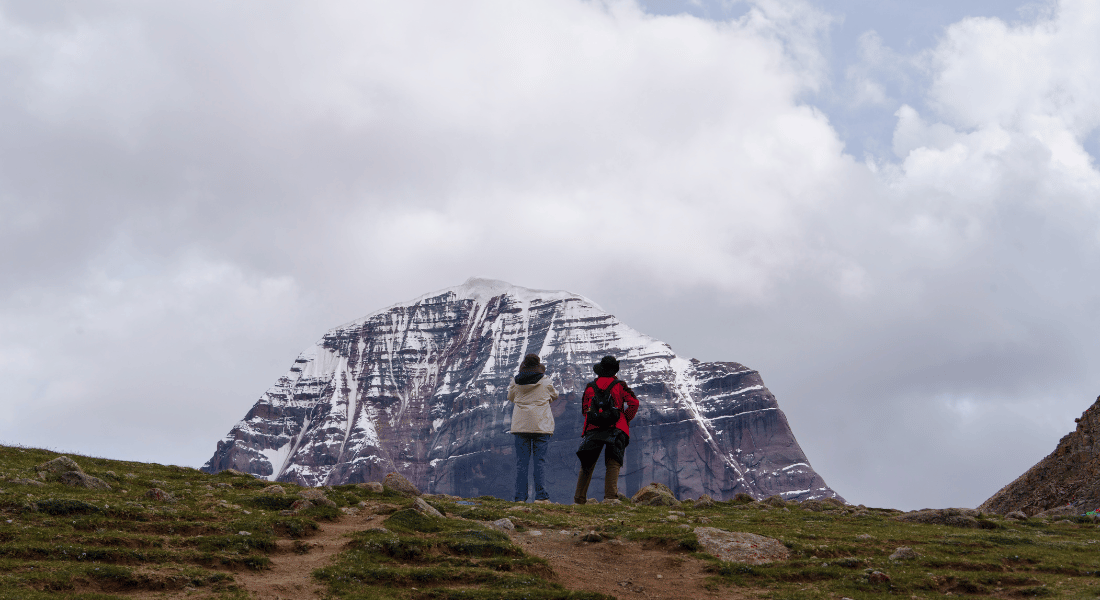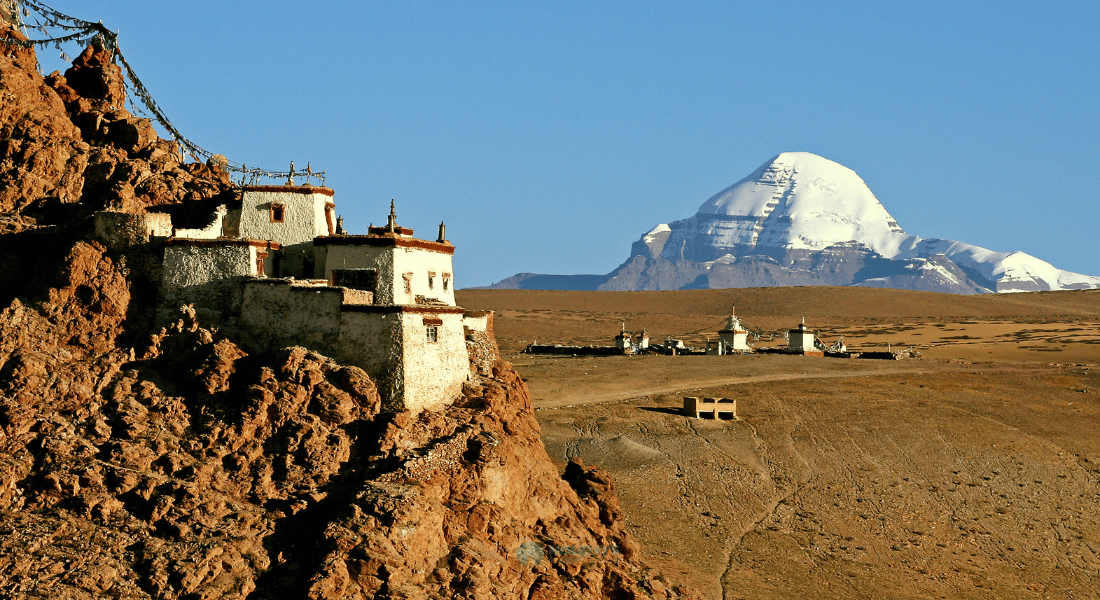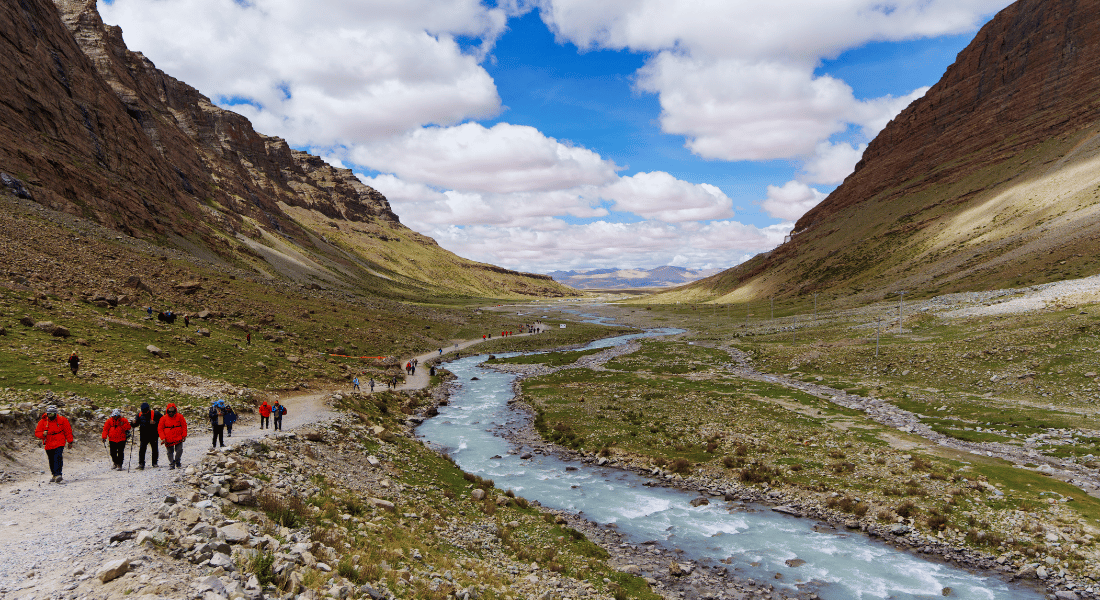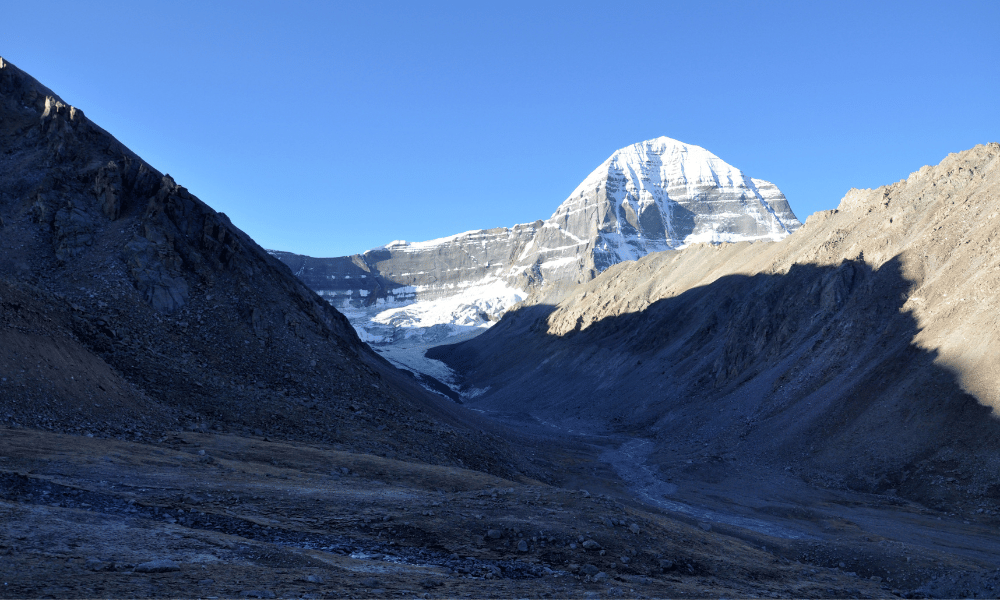As an NRI living abroad, are you looking for a way to participate in the Kailash Mansarovar Yatra? Our Kailash Mansarovar Yatra for NRIs is a helpful guide to provide information regarding spiritual guidance, logistical advice, or cultural context related to the Kailash Mansarovar Yatra. It majorly covers different aspects of the journey, such as yatra significance, cost associated, yatra routes, and some travel tips you should be aware of.
Kailash Mansarovar Yatra lets you participate in the sacred Kora around Mount Kailash and visit the holy Lake Mansarovar, which are the significant highlights of the yatra. For the NRIs, undertaking the Kailash Mansarovar Yatra can be both a homecoming and a once in a lifetime opportunity, as living abroad often makes you distant from the cultural and spiritual roots that shape one's identity. As an NRI, you might face challenges in understanding visa requirements, which is given special attention in the section “visa and documentation” of the blog.
Kailash Mansarovar Yatra is not an ordinary trip, as it needs thorough planning and preparation to overcome the challenges related to the yatra. As you will be travelling from abroad to Nepal and Tibet, there are various logistical procedures, including visas and documentation, which is a big headache. In this guide, you’ll explore everything an NRI needs to know before you participate in this sacred journey.
Kailash Mansarovar Yatra Facts
Here are some facts related to the Kailash Mansarovar Yatra:
|
Facts |
Details |
|
Journey |
Kailash Mansarovar Yatra |
|
Duration |
|
|
Major Attractions |
|
|
Average Altitude |
4000 m |
|
Difficulty |
Strenuous |
|
Max Elevation |
Dolma la Pass (5600 m) |
|
Best Time to Visit |
May to September |
|
Required Travel Documents |
|
Why visit Kailash Mansarovar?
Mount Kailash, the holy abode of Lord Shiva, is a highly venerated pilgrimage situated in the autonomous region of China-Tibet at an altitude of 6638 m, and Lake Mansarovar is yet another site at an altitude of 4650 m. Participating in the Kailash Mansarovar Yatra offers a profound spiritual experience that is often considered a once in a lifetime opportunity. The journey to Mount Kailash and Lake Mansarovar is deeply rooted in ancient traditions and is revered in Hinduism, Buddhism, Jainism, and Bon.


Kailash Mansarovar Yatra, also known as cirumumbulation or Kora around this majestic mountain and exploration of holy lake Mansarovar draws a huge number of devotees around the world for its religious, cultural, and spiritual significance. This ritual is believed to free one from your sins and bring inner peace. It is a quest for spiritual purification and enlightenment.
Beyond its spiritual and cultural aspects, Kailash Mansarovar Yatra is renowned for its breathtaking natural beauty and challenging terrain. It lets you connect with the untouched beauty of the Tibetan Himalayas, adding to the pilgrimage value of the journey. The barren landscape and rugged terrain make the yatra difficult yet physically rewarding to grow an individual's endurance. Which is why the Kailash Mansarovar Yatra is even more significant among the participants who are adventurous and are ready to test their strength and ability.
Also Read: What is Kailash Mansarovar Yatra?
Planning the Yatra: Key Considerations for NRIs
As a traveller, planning the yatra itself is a difficult task, as you need to consider various aspects to make sure that your journey is successful. To make sure that your trip is carefully planned with proper information, here are some key considerations in planning the trip for NRIs.
|
Visa and Documentation |
|
Health and Fitness |
|
Altitude sickness and acclimatisation |
|
Best Time to Visit Kailash Mansarovar |
|
Packing Requirements |
|
Choosing a reliable travel agency |
|
Understanding the yatra difficulty |

Visa and Documentation
First and foremost, a passport is a mandatory document for any international traveler. All the NRIs with a 9-month valid passport are eligible for the Kailash Mansarovar Yatra. As you will need to visit Nepal first, NRIs can get an on arrival visa from the airport or any immigration office at the border. Besides that, you must get a Tibet Travel visa to enter Tibet. All the required documents will be arranged by the travel agency you’ll be travelling with, as individual applications are not accepted for this yatra. Always ensure that your documentation is complete and processed early to avoid last-minute issues.
Provided is the on arrival visa cost for NRIs to enter Nepal:
|
Visa Duration |
Visa Cost |
|
15 days |
USD 30 |
|
30 days |
USD 50 |
|
90 days |
USD 125 |
Note: The visa cost is subject to change; please visit the Nepal Immigration Website for updated information.
Health and Fitness
For the Kailash Mansarovar Yatra, physical fitness plays a crucial role in the success of the yatra. The journey involves trekking at high altitudes, rugged terrains, and harsh climates, which can be particularly challenging for those who are not well prepared. To participate in the yatra, participants should involve themselves in strength-building exercises that help you grow your endurance. Before the yatra, you are suggested for thorough medical checkups to make sure you are fit for the yatra. You are advised to consult your doctor if you’re suitable for the high-altitude journey above 4000 m. Most importantly, individuals with heart conditions, severe asthma, or high blood pressure are required to give more attention to their health.
Altitude Sickness and acclimatisation
Kailash Mansarovar Yatra is a journey to high altitude with an average altitude of 4000 m and maximum elevation of about 5600 m. A normal person reaching that altitude can cause serious altitude sickness, which cannot be overlooked. As you process for the yatra, the symptoms such as headache, nausea, and loss of appetite can develop gradually. One must be aware of this and acclimatise properly. Acclimatisation helps you in the gradual adaptation of the environment. It's important to ascend slowly and allow your body time to adjust to the lower oxygen levels. Staying hydrated, avoiding alcohol, eating light, and walking at a slower pace are practical tips for minimising the effects of altitude.
Best Time to Visit Kailash Mansarovar
The most favourable time to visit Kailash Mansarovar Yatra is from May to September, when the weather is at its best. During these months the temperature is pleasant and the skies are mostly clear, which ensures a safe trek with fewer chances of rain and snowfall. The months from October to April are not recommended due to heavy snowfall and extreme cold. In these months, the area is also closed for tourists, as it might not be safe during this time. Planning your trip during the right time ensures a safer and more enjoyable pilgrimage.
Learn More: Best time to Visit Kailash Mansarovar
Packing Requirements
As Kailash Mansarovar is a difficult journey, you might get confused on what to pack and what to not. To make sure you won’t miss out on the most required, listed below are some packing essentials for the Kailash Mansarovar Yatra:
|
Clothing |
Essentials |
Additional Items |
|
Warm and comfortable clothes |
Soap/Shampoo |
Travel Documents (Permits/Visa) |
|
Shoes |
Toiletries |
Camera, Batteries, Binocular, hiking poles |
|
Shorts |
Dust Mask and Sanitizer |
Headlamp |
|
Trekking Pants |
Toilet paper, wet tissues |
First aid kit |
|
Long Sleeved Shirt |
Quick-dry towel |
Documents (Passport, Permits, Visa) and Cash |
|
Fleece |
Sunglasses |
Water Bottle |
|
Rain Jacket |
Sunscreen |
Plastic bags, Deo, thread, and needle |
Learn More: Kailash Mansarovar Yatra Packing List
Choosing a reliable travel agency
You can apply for or participate in the Kailash Mansarovar Yatra as an individual. Given the border crossing process and strict Tibet regulations, you need to proceed with your documents and application through a reliable travel agency. A good agency will offer comprehensive packages that cover everything from transport, accommodation, and meals to guides and porters, along with medical support during the trek. You can read reviews and testimonials from previous clients of the agency to determine the reliability of the agency. It's important to choose a company with knowledgeable guides who are experienced in high-altitude treks, as this can significantly enhance your safety and overall experience. With that being said, make sure to check out Holidays to Nepal to make sure your Yatra logistics are handed over to a reliable agency.
Understanding the yatra difficulty
Kailash Mansarovar Yatra is one of the most revered destinations with high physical demands yet a rewarding one. You will require a high level of physical as well as mental strength to endure the high altitude, difficult terrain, and unexpected weather conditions. The trek around Mount Kailash, known as the Kora, is particularly challenging, spanning about 52 km and often taking three days to complete. It involves steep ascents, rugged terrain, and crossing high passes, such as the Dolma La Pass, which reaches an elevation of 5600 m. For those new to high altitudes or long-distance trekking, this yatra can pose significant challenges. You must understand these difficulties before the yatra and prepare accordingly from physical fitness to packing wisely.
Also Read: 10 Must Know Things Before Kailash Mansarovar Yatra
Recommended Packages
Choosing the right package can significantly affect your Yatra experience, especially for the NRIs who are unfamiliar with the region's logistics and environment. Provided are some recommended packages that might suit your travel type, durations, and routes you might prefer.
Kailash Mansarovar Yatra by Drive

The Kailash Mansarovar Yatra by Drive, starting from Nepal and passing through Kyirong, offers pilgrims a profound spiritual journey. Surrounded by the mystical Tibetan plateau, Mount Kailash and Mansarovar Lake are recognised as sacred landmarks that inspire awe. The route through Kyirong, a border town, presents breathtaking views of the Himalayas and rich Tibetan culture.
Outline Itinerary
|
DAY 01: Kathmandu Arrival. |
|
DAY 02: Visa Application, Kathmandu Sightseeing. |
|
DAY 03: Bhaktapur Sightseeing. |
|
Day 04: Chandragiri Sightseeing. |
|
Day 05: Packing and Final Preparation. (Buffer Day) |
|
Day 06: Drive to Dhunche or Syabrubesi or Timure. |
|
Day 07: Drive to Kyirong. (2850 m) |
|
Day 08: Drive to Saga. (4500 m) |
|
Day 09: Drive to Lake Mansarovar. (4650 m) |
|
Day 10: Drive to Darchen. (4700 m) |
|
Day 11: Drive to Yama Dwar, Trek to Derapuk. (5050 m) |
|
Day 12: Trek to Zuthulpuk. (4800 m) |
|
Day 13: Zuthulpuk to Saga. (4500 m) |
|
Day 14: Drive back to Kyirong. (2850 m) |
|
Day 15: Drive to Kathmandu. (1400 m) |
|
Day 16: Departure. |
Learn More: Kailash Mansarovar by Drive via Kyirong
Kailash Mansarovar Yatra by Helicopter

The Kailash Mansarovar Yatra by helicopter offers a convenient spiritual tour to Mount Kailash and the holy Lake Mansarovar. This option provides a faster and easier way to complete the journey, making it ideal for seniors or those who may struggle with the long drive from the Kyirong side. The trip begins with a land journey to Nepalgunj, followed by a helicopter ride to Hilsa, and then a drive to reach Mansarovar. This package ensures a fulfilling experience while minimising the physical demands of the yatra.
Outline Itinerary
|
DAY 01: Kathmandu Arrival. |
|
DAY 02: Visa Application, Kathmandu Sightseeing. |
|
DAY 03: Bhaktapur Sightseeing. |
|
Day 04: Chandragiri Sightseeing. |
|
Day 05: Packing, Fly to Nepalgunj. |
|
Day 06: Fly from Nepalgunj to Simikot. (2812 m) |
|
Day 07: Simikot to Hilsa to Taklakot. (3900 m) |
|
Day 08: Acclimatisation day at Taklakot. |
|
Day 09: Drive from Taklakot to Lake Mansarovar. (4650 m) |
|
Day 10: Drive to Yama Dwara, Trek to Derapuk. (5050 m) |
|
Day 11: Trek to Zuthulpuk. (4800 m) |
|
Day 12: Zuthulpuk to Hilsa or Simikot. |
|
Day 13: Hilsa to Simikot, Fly back to Kathmandu via Nepalgunj. |
|
Day 14: Departure. |
Learn More: Kailash Mansarovar Yatra by Helicopter
Kailash Mansarovar Yatra via Lhasa with EBC

This tour package enhances your Kailash Mansarovar pilgrimage with a visit to Lhasa and Everest Base Camp. It offers a spiritual adventure through the stunning landscapes of the Himalayas, including Mount Kailash, Lake Mansarovar, and North Everest Base Camp. Along the way, you'll explore the cultural highlights of Kathmandu, Bhaktapur, and Lhasa, making it a truly enriching and transformative experience.
Outline Itinerary
|
DAY 01: Kathmandu Arrival. |
|
DAY 02: Visa Application, Kathmandu Sightseeing. |
|
DAY 03: Bhaktapur Sightseeing. |
|
DAY 04: Visa Collection, Trip Preparation. |
|
DAY 05: Fly to Lhasa. |
|
DAY 06: Lhasa Sightseeing. |
|
DAY 07: Lhasa Sightseeing. |
|
DAY 08: Drive to Shigatse. |
|
DAY 09: Drive to Tingri (4348 m), Explore Everest Base Camp. |
|
DAY 10: Drive to Saga (4500 m). |
|
DAY 11: Drive from Saga to Lake Mansarovar. (4650 m) |
|
DAY 12: Drive to Darchen. (4700 m) |
|
DAY 13: Drive to Yama Dwara, Trek to Derupuk. (5050 m) |
|
DAY 14: Trek to Zuthulphuk, Drive to Darchen. (4650 m) |
|
DAY 15: Drive to Kyirong. |
|
DAY 16: Drive to Kathmandu. |
|
DAY 17: Departure. |
Learn More: Kailash Mansarovar Yatra via Lhasa with EBC
Short Kailash Mansarovar Yatra Package

Our Short Kailash Mansarovar Yatra Package is perfect for NRIs and foreigners seeking a meaningful spiritual journey within a limited timeframe. It includes convenient heli transfers to reduce travel time, designed to cover the sacred Mount Kailash and Lake Mansarovar in just 13 days. Ideal for those with busy schedules, it offers a transformative experience, blending spirituality with breathtaking landscapes in one of the world’s most revered pilgrimage destinations.
Outline Itinerary
|
DAY 01: Kathmandu Arrival. |
|
DAY 02: Visa Application, Kathmandu Sightseeing. |
|
DAY 03: Bhaktapur Sightseeing. |
|
DAY 04: Trip Preparation, Fly to Timure. |
|
DAY 05: Drive to Kyirong. (2850 m) |
|
DAY 06: Drive to Saga. (4500 m) |
|
DAY 07: Drive from Saga to Lake Mansarovar. (4650 m) |
|
DAY 08: Drive to Darchen. (4700 m) |
|
DAY 09: Drive to Yama Dwara, Trek to Derapuk. (5050 m) |
|
DAY 10: Trek to Zuthulphuk, Drive to Darchen. (4650 m) |
|
DAY 11: Drive to Kyirong. |
|
DAY 12: Drive back to Timure, Fly to Kathmandu. |
|
DAY 13: Departure. |
Learn More: Short Kailash Mansarovar Yatra
Kailash Mansarovar Yatra Cost for NRIs
Preparing for the Kailash Mansarovar Yatra means considering various factors related to the Yatra, including the cost, which is the most significant part of any journey. In the Kailash Mansarovar Yatra, the cost is affected by factors such as major factors such as travel type and package you choose, while other aspects such as transportation, accommodation options, permits and visas, and personal expenses also affect your cost. Having a clear understanding of the costs helps NRIs select a suitable package that aligns with both their spiritual goals and budgetary considerations.
|
Travel Type |
Packages |
Cost |
|
Private |
Short Kailash Mansarovar Yatra |
USD 4500 pp |
|
Kailash Inner Kora Tour |
USD 5500 pp |
|
|
Kailash Mansarovar Yatra via Lhasa with EBC |
USD 6000 pp |
|
|
USD 5000 pp |
||
|
Group |
Kailash Mansarovar Yatra by Drive via Kyirong |
USD 3000 pp |
|
Kailash Mansarovar Yatra by Helicopter |
USD 4200 pp |
Cost Breakdown
Given are the costs categorised into different aspects of the Yatra. You can find the details as mentioned:
|
Cost Category |
Details |
|
Permit |
Tibet Travel Permit (TTP) |
|
Modes of Transportation |
|
|
Accomodation Options |
Nepal Side
Tibet Side
|
|
Meals |
Nepal Side
Tibet Side
|
|
Permit |
Tibet Travel Permit (TTP) |
|
Personal Expenses |
|
Learn More: How Much Does Kailash Mansarovar Yatra Cost?
Travel tips for Successful Yatra
A new destination and unfamiliar environment pose various curiosity regarding different aspects related to the region. There’s always something more you must be aware of. To fulfil your curiosity and acknowledge you on these little things below are some essential travel tips covering key aspects such as currency, respecting local customs, packing wisely, and securing proper insurance, all of which will help you navigate the challenges and enrich your overall Kailash Mansarovar experience.

Currency
One must be aware of the local currency being used in the place you’re travelling to. For Kailash Mansarovar, you’re advised to carry a Chinese currency in small and exchangeable amounts for convenience, as it is the only currency that is accepted in that region. The currency exchange rate for Yuan in dollars is 1 Chinese Yuan = USD 0.14, and the exchange rate for Yuan in Nepalese rupees is 1 Chinese Yuan = NPR 18.94. You can exchange it directly through banks, travel agencies, or the immigration office before crossing the border. It is important to carry enough cash, as ATMs might not be easily available and cards may not be accepted.
Respect local customs
Tibet is a land rich in spiritual traditions, and the Kailash Mansarovar Yatra is as much a cultural experience as it is a spiritual pilgrimage. It’s important to respect local customs and traditions during your journey to ensure a harmonious experience with the local Tibetan people. Make sure to dress modestly when visiting temples and monasteries, which includes wearing respectful attire and avoiding revealing clothes. You need to be mindful of the local way of life, which is deeply spiritual and deeply connected with nature. Always ask before taking photos of local people, and avoid making gestures that might be considered disrespectful.
Pack wisely
For a journey lasting more than 10 days, there might be a lot to carry, and you might miss out on important things. While packing, only the requirements are not important, but how you pack also plays a huge role in the comfortable yatra. The key to packing is to pack light yet be fully prepared for unpredictable weather. From layering your clothes to where to pack, a good backpack makes your whole journey comfortable.
Insurance
Due to the risks associated with the high-altitude trek in this remote region of Tibet, it is highly recommended to purchase travel insurance to cover the risks associated with the yatra. You are suggested to obtain comprehensive travel insurance that not only covers medical expenses but evacuation and emergency medical services. Additionally, consider a plan that covers trip cancellations, delays, lost baggage, and unforeseen natural events that might disrupt your travel plans. To make sure you have the right kind of insurance, you can also ask for recommendations from the travel agencies you’re travelling with.
Conclusion
Kailash Mansarovar Yatra, a journey considered sacred by Hindus, Buddhists, Jains, and Bon followers. In this yatra, pilgrims can not only involve themselves in the religious experience but witness the majestic natural beauty of Tibet. Apart from its spiritual, natural, and religious significance, the journey comes with a set of logistics challenges that are often considered the behind the scenes of any journey; however, this is the most important part that cannot be ignored.
This sacred yet physically demanding trek with its high altitude and remote terrain challenges your body while the serene environment and sacred energy purify your soul. As you plan your yatra, remember to prioritise your physical and mental well-being. You need to acclimatise properly, pack essentials, and be prepared for the challenges that the high-altitude environment may present.
This blog has aimed to highlight the various aspects of the journey, which works as valuable information required for the NRIs to participate in the Kailash Mansarovar Yatra. From the spiritual and cultural context to the logistic context, it hopes that each and every participant of the Kailash Mansarovar Yatra has more knowledge and fewer problems during the journey.

